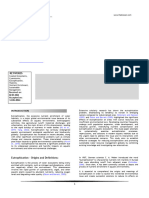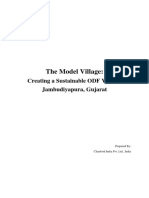0 ratings0% found this document useful (0 votes)
59 viewsProject 2
Project 2
Uploaded by
api-253716121Copyright:
© All Rights Reserved
Available Formats
Download as DOCX, PDF, TXT or read online from Scribd
Project 2
Project 2
Uploaded by
api-2537161210 ratings0% found this document useful (0 votes)
59 views3 pagesOriginal Title
project 2
Copyright
© © All Rights Reserved
Available Formats
DOCX, PDF, TXT or read online from Scribd
Share this document
Did you find this document useful?
Is this content inappropriate?
Copyright:
© All Rights Reserved
Available Formats
Download as DOCX, PDF, TXT or read online from Scribd
Download as docx, pdf, or txt
0 ratings0% found this document useful (0 votes)
59 views3 pagesProject 2
Project 2
Uploaded by
api-253716121Copyright:
© All Rights Reserved
Available Formats
Download as DOCX, PDF, TXT or read online from Scribd
Download as docx, pdf, or txt
You are on page 1of 3
MEMORANDUM
To: Professor Karen Thompson
From: Jessie Balbiani
Date: 16 February 2014
Subject: Writing to Define and Describe
The following memorandum provides an extended technical definition and a developed technical
description of a process known as eutrophication and how it affects water resources. The PSA, or
problem-solving approached, was used to clearly identify the audience, the problem, and the purpose of
the requested definition and description.
Audience
The audience is the same for both the extended technical definition and the developed technical
description. Since the subject matter is largely regarding water quality and management, the applicable
audience is broad. It includes anyone affected by degraded water quality such as property owners,
residential communities near water, water managers, environmentally inclined students, recreational
water users, and residents who do not receive their drinking water from a well.
Problem
Water is one of the most threatened resources on the planet. As more developers and residents
encroach on the banks of freshwater bodies, increasing amounts of pollutants enter and contaminate
precious water resources. Not only is this a problem for society, but it also raises huge concerns for the
ecosystem as wellcausing severe and often irreversible damage. The inflow of these pollutants often
leads to a phenomenon known as eutrophication. According to the journal of Limnology and
Oceanography, eutrophication is the number one threat to freshwater resources in the year 2013.
Purpose/Placement
Extended Technical Definition
The purpose of the extended technical definition is to define the process of eutrophication at its
most basic level. Here I define the term and explain the process in terms of watershed
characteristics, runoff properties, nutrient transport, algae behavior, and lake shallowing. This
definition was written as a precursor to the developed technical description and would be
placed at the beginning of a brochure.
Developed Technical Description
The purpose of the developed technical description is to put the definition of eutrophication in
modern context and elaborate on the current issue of cultural eutrophication. It is important
first to understand what eutrophication is in a pristine environment before one can understand
the concept of cultural eutrophication. This description was written to follow the technical
definition of eutrophication and would be placed following that definition in a brochure.
Extended Technical Definition
Eutrophication
Eutrophication is a naturally occurring process often referred to as the natural aging of a lake. From the
moment a lake is formed it begins to age, that is to say transform from wet land back to a state of dry
land. All lake systems are temporary and are merely in the process of filling in and becoming dry land.
This transformation normally takes hundreds or thousands of years and is caused by the process of
eutrophication.
As water runs over the surface of a watershed, it picks up sediments and organic material. In the
sediments and organic material are nutrients. For the purpose of this definition, the nutrients of interest
are Nitrogen and Phosphorus which are found in almost all life forms and accumulate easily in
sediments. Water from precipitation, snowmelt, and streams continue to move through the watershed,
collecting more and more nutrients. All of these water sources eventually meet and collect into one lake
at the base of the watershed. Here the nutrients transported by streams and runoff concentrate into the
lake.
The nutrients are a vital food source for algae. The increased concentrations of nutrients allow algae to
reproduce resulting in large algae blooms. The blooms restrict the amount of light able to penetrate the
water and cause aquatic plants to die. Eventually the bloom reaches a size no longer sustainable by the
available nutrients and the algae also begin to die. The dead algae and aquatic plants sink to the bottom
of the lake and decomposed, adding to the bottom lake sediments and slightly shallowing the overall
depth of the lake. With the algae gone, the lake balance returns and new plants grow.
The process then repeats; more nutrients enter the lake system allowing algae to grow, aquatic plants
die, algae die, sediment builds up at the bottom of the lake, and the lake shallows. Eventually, as the
lake becomes more shallow with time, the lake sediments provide suitable habitat for a wider variety of
plants that are able to take root and reproduce in the shallow zones. This fosters a positive feedback
by becoming shallower the sediments are available to more plants that thus cause accelerated
shallowing. After centuries of this process repeating the lake changes from a waterbody to a wetland to
a marsh and finally to solid dry land.
While this process is sometimes viewed as the death of an ecosystem, it is also considered the birth of a
new ecosystem. It is important to note as well that the process of lake aging and eutrophication occur
over hundreds of yearsgiving the plant and animal communities time to adjust and adapt to the
changing environment.
Developed Technical Description
Cultural Eutrophication
As defined previously, eutrophication is
a naturally occurring process in which
nutrients enter a waterbody and cause
the gradual shallowing of a lake over
the course of hundreds of years. The
problem we face today is a new
phenomenonthat of accelerated or
cultural eutrophication.
The Process
Cultural eutrophication, like natural
eutrophication, happens as a result of an increased input of nutrients into a waterbody. The difference is
the source of the nutrient. Natural eutrophication receives nutrients from soil and organic material
present in the watershed. Cultural eutrophication receives nutrients from those sources as well as man-
made sources. As a result a lake undergoing cultural eutrophication experiences unnaturally large input
of nutrients that accelerates the eutrophication process. Instead of occurring over centuries, cultural
eutrophication can happen in a matter of decades.
Sources of Nutrients
Where do these man-made sources of nutrient come from? Modern human activities and practices like
agricultural fertilizing, sewage waste, runoff from urban areas, increased erosion from deforestation,
and residential fertilizer use all
contribute excess nitrogen and
phosphorus into water
resources.
As shown in the pie charts, 50
percent of more of Nitrogen and
Phosphorus come from diffuse
(non-point) sources and point
sources. Non-point sources
include runoff from agricultural
lands and residential lawns that
have been heavily fertilized with nutrients. Point sources are things like sewage pipes and waste water
drains that input heavy nutrient water into natural water systems.
The Problem
In a natural environment not influence by human behaviors and contaminates, lake shallowing caused
by eutrophication can occur over centuries. Now cultural eutrophication allows the process to happen
over decades. The rapid decrease in time prevents the system from recovering and sustaining a healthy
ecosystem. Cultural eutrophication causes abnormally large algae blooms that consume all oxygen in
the water during the decomposition process which leads to massive fish kills and the collapse of the
food chain. The high amounts of phosphorus also foster the growth of cyanobacteria, a form of blue-
green algae toxic if ingested. The cyanobacteria blooms can poison drinking water and destroy the
beneficial uses of a lake system.
You might also like
- Plumbing Inspection Checklist - Form 11.7Document1 pagePlumbing Inspection Checklist - Form 11.7Justin Rolfe67% (3)
- EutrophicationDocument8 pagesEutrophicationashuchemNo ratings yet
- Sedimentation PresentationDocument30 pagesSedimentation PresentationShepherd Nhanga100% (3)
- Department of Civil and Environmental Engineering Shahjalal University of Science and Technology, SylhetDocument22 pagesDepartment of Civil and Environmental Engineering Shahjalal University of Science and Technology, Sylhetshajib_sustNo ratings yet
- Neutrophication Can Be HumanDocument5 pagesNeutrophication Can Be HumanPerkresht PawarNo ratings yet
- Bio Report (Human Impact On The Environment)Document31 pagesBio Report (Human Impact On The Environment)姐姐雯No ratings yet
- What Is Eutrophication?Document6 pagesWhat Is Eutrophication?Zain Ali AwanNo ratings yet
- Study and Assessment of An Eutrophied Inland Water BodyDocument73 pagesStudy and Assessment of An Eutrophied Inland Water BodyAnu CherianNo ratings yet
- Unusual Properties of WaterDocument21 pagesUnusual Properties of WaterKyla ReyesNo ratings yet
- Eutrophication and Algal BloomsDocument5 pagesEutrophication and Algal Bloomsmaheswarimelam2004No ratings yet
- EutrophicationDocument4 pagesEutrophicationdikshakaushal900No ratings yet
- EEK Uman Nteraction and Pollution: NIT VerviewDocument8 pagesEEK Uman Nteraction and Pollution: NIT Verviewpradip_kumarNo ratings yet
- Eutrophication and The Classification of LakeDocument6 pagesEutrophication and The Classification of LakeMuhammad Anand ArdhiansyahNo ratings yet
- Sih1005 - P3Document11 pagesSih1005 - P323005852No ratings yet
- EutrophicationDocument4 pagesEutrophicationgomathi_nellaiNo ratings yet
- PollutionDocument6 pagesPollutionMehvish ChohanNo ratings yet
- Eutrophication: An IntroductionDocument8 pagesEutrophication: An IntroductionHari NarayananNo ratings yet
- Water As A ResourceDocument28 pagesWater As A ResourceArjuna PagdilaoNo ratings yet
- TE434 Week 3 Ecological System Disturbances and Pollutions Water Pollution - Quality 2Document26 pagesTE434 Week 3 Ecological System Disturbances and Pollutions Water Pollution - Quality 2Althea Luz BalgameNo ratings yet
- 4-1 Introduction: This Chapter Was Written by John A. Eastman, PH.D., of Lockwood, Jones and Beals, Inc., Kettering, OHDocument12 pages4-1 Introduction: This Chapter Was Written by John A. Eastman, PH.D., of Lockwood, Jones and Beals, Inc., Kettering, OHSirajuddin AhmedNo ratings yet
- Riverfront DevelopmentDocument31 pagesRiverfront DevelopmentSharmila GangulyNo ratings yet
- Eutrophication and Restoration of Indian LakesDocument27 pagesEutrophication and Restoration of Indian LakesRashmi Nayaka100% (6)
- General Outline of The Course: Personal Addition: "Document6 pagesGeneral Outline of The Course: Personal Addition: "Shepherd NhangaNo ratings yet
- Field Study of EcosystemDocument10 pagesField Study of EcosystemUmapathy Harish HarishNo ratings yet
- EcologyDocument12 pagesEcologyrachelmvaz99No ratings yet
- This Is Due To The Prevalence of Water On The Planet's SurfaceDocument4 pagesThis Is Due To The Prevalence of Water On The Planet's SurfacesophieNo ratings yet
- What Is Eutrophication? Causes, Effects and Control: Home / Water / Special ReportsDocument6 pagesWhat Is Eutrophication? Causes, Effects and Control: Home / Water / Special ReportsChinnu ChinnusNo ratings yet
- Water Pollution ControlFrom EverandWater Pollution ControlSuresh T. NesaratnamNo ratings yet
- EutrophicationDocument8 pagesEutrophicationAbhijitNo ratings yet
- A4 EutrophicationDocument2 pagesA4 EutrophicationRovv icNo ratings yet
- BB 3Document2 pagesBB 3krushnabankar79No ratings yet
- Water Pollution Abdesadek ELKAHALDocument53 pagesWater Pollution Abdesadek ELKAHALAbdessadek El KahalNo ratings yet
- Physico-Chemical Aspects of LakesDocument41 pagesPhysico-Chemical Aspects of LakesH Janardan PrabhuNo ratings yet
- Unit 2 BDocument6 pagesUnit 2 Bdakshata0409No ratings yet
- Describe A Specific Ecosystem Type of FreshwaterDocument7 pagesDescribe A Specific Ecosystem Type of FreshwaterCharle TsaiNo ratings yet
- Aquatic EcosystemsDocument2 pagesAquatic EcosystemsJonas ColipanoNo ratings yet
- Complete White PaperDocument3 pagesComplete White Paperapi-745003609No ratings yet
- Di AtomDocument15 pagesDi AtomNikhil AcharyaNo ratings yet
- CH311 Literature ReviewDocument6 pagesCH311 Literature ReviewNarelle Iauma100% (1)
- Apes Final Project 1 - CompressedDocument10 pagesApes Final Project 1 - Compressedapi-757906338No ratings yet
- What Is EutrophicationDocument28 pagesWhat Is EutrophicationSoumya ShuklaNo ratings yet
- Q2S1 Earth Science NotesDocument15 pagesQ2S1 Earth Science NotesMitch Layos PadronesNo ratings yet
- WATER EnvironmentDocument12 pagesWATER EnvironmentLance Hernandez100% (1)
- Eutrophication: Causes, Impacts and Control StrategiesDocument3 pagesEutrophication: Causes, Impacts and Control StrategiesManya WadhwaniNo ratings yet
- Pond Ecosystem BodyDocument17 pagesPond Ecosystem BodySourav Kumar Samanta71% (55)
- Unit4 Sustainability PARTA r1Document23 pagesUnit4 Sustainability PARTA r1Arun KumarNo ratings yet
- Neeeew Water - PollutionDocument14 pagesNeeeew Water - PollutionDl Al-azizNo ratings yet
- Earth Science Second Quarter NotesDocument14 pagesEarth Science Second Quarter NotesNicolle P. PelagioNo ratings yet
- Thesis Final 10.11.2010Document102 pagesThesis Final 10.11.2010vijay2382No ratings yet
- Environmental Effects (EUTROPHICATION)Document2 pagesEnvironmental Effects (EUTROPHICATION)ZhllAnneNo ratings yet
- Aquatic Eco SystemDocument37 pagesAquatic Eco Systemhitman agent 47No ratings yet
- EutrophicationDocument5 pagesEutrophicationNarelle IaumaNo ratings yet
- DephnieDocument13 pagesDephnieKey OnNo ratings yet
- Environmental ScieDocument4 pagesEnvironmental ScieJustine PredillaNo ratings yet
- The Mitigation MeasuresDocument4 pagesThe Mitigation MeasuresArf ZizNo ratings yet
- Week 5Document5 pagesWeek 5Lebanan Aprille MarieNo ratings yet
- Eutrophic at I OnDocument7 pagesEutrophic at I OnKrizelle Mae BaronganNo ratings yet
- Water and Waste MGMTDocument7 pagesWater and Waste MGMTSATUR LABRADURNo ratings yet
- EutrophicationDocument22 pagesEutrophicationdelight photostateNo ratings yet
- Reaction Paper - Video 12A, B, C Sources of Wastewater and How It Is Treated in The Wastewater PlantDocument3 pagesReaction Paper - Video 12A, B, C Sources of Wastewater and How It Is Treated in The Wastewater PlantChilton John DuatNo ratings yet
- Freshwater Ecosystems.Document16 pagesFreshwater Ecosystems.Khylle Rey FanugaNo ratings yet
- Scopus Cited JournalsDocument7 pagesScopus Cited Journalsmounikad.openventioNo ratings yet
- Adobe Scan 12 Feb 2024Document6 pagesAdobe Scan 12 Feb 2024dass39209No ratings yet
- GroundwaterDocument18 pagesGroundwaterAli AhmadNo ratings yet
- Sampling and Analysis of Industrial WasteDocument39 pagesSampling and Analysis of Industrial WasteIndrajeet UpadhyayNo ratings yet
- Losses From Precipitation: Module-2Document40 pagesLosses From Precipitation: Module-2rohitNo ratings yet
- Disaster Management PYQs - SHREYA SHREEDocument9 pagesDisaster Management PYQs - SHREYA SHREEasdNo ratings yet
- On Drought Management-EnglishDocument20 pagesOn Drought Management-Englishmuskanjangra1234No ratings yet
- Manual Eng in 2Document5 pagesManual Eng in 2Thiago GomesNo ratings yet
- ZCoastal LagoonsDocument5 pagesZCoastal Lagoons19-2026 Khaisya PutriNo ratings yet
- Activated SludgeDocument16 pagesActivated SludgeWëllë MåsëksNo ratings yet
- Kubota-Mbr Technical PDFDocument13 pagesKubota-Mbr Technical PDFpragatheeskNo ratings yet
- Wa0019.Document8 pagesWa0019.Abi officeNo ratings yet
- English SBA ArtefactsDocument5 pagesEnglish SBA ArtefactsCelene RamoutarNo ratings yet
- Readers' Theater Script: Water Cycle AdventureDocument4 pagesReaders' Theater Script: Water Cycle AdventureZexeriNo ratings yet
- BMP Dry Detention PondsDocument6 pagesBMP Dry Detention PondsLudwig McwillsNo ratings yet
- Sediment Control in CanalsDocument4 pagesSediment Control in CanalsVivek KumarNo ratings yet
- Plumbing Code Refresher Set ZDocument14 pagesPlumbing Code Refresher Set ZJomarie AlcanoNo ratings yet
- Pwsid: Metropolitan 2591: SystemDocument4 pagesPwsid: Metropolitan 2591: SystemMonica DiazNo ratings yet
- Plumbing PrinciplesDocument39 pagesPlumbing PrinciplesNicole NovesterasNo ratings yet
- Goal 6: Clean Water and SanitationDocument3 pagesGoal 6: Clean Water and SanitationNazakat HussainNo ratings yet
- Jambudiyapura Project ReportDocument9 pagesJambudiyapura Project ReportSanjay DeshpandeNo ratings yet
- CH PE AnInspRpt 001 20160114Document75 pagesCH PE AnInspRpt 001 20160114online reviewNo ratings yet
- Building Utilities Plumbing 1Document4 pagesBuilding Utilities Plumbing 1Christian James Tuazon100% (1)
- Water Quality Thesis ProposalDocument8 pagesWater Quality Thesis Proposalfj9dbfw4100% (2)
- Intake WellDocument16 pagesIntake WellSatish BagulNo ratings yet
- WASH-Questions Bank For WASH Site EngineerDocument2 pagesWASH-Questions Bank For WASH Site EngineerYounas Wisal100% (4)
- Kwara State Water Quality Frame WorkDocument4 pagesKwara State Water Quality Frame Workcalebo_Fuoye123No ratings yet
- Rivers of BangladeshDocument3 pagesRivers of BangladeshRanathunga ThennakoonNo ratings yet

























































































